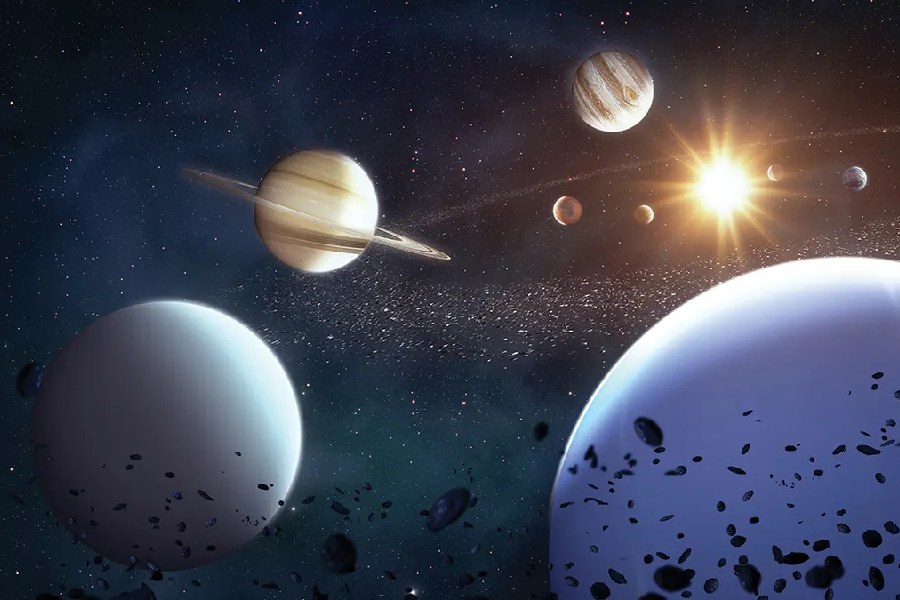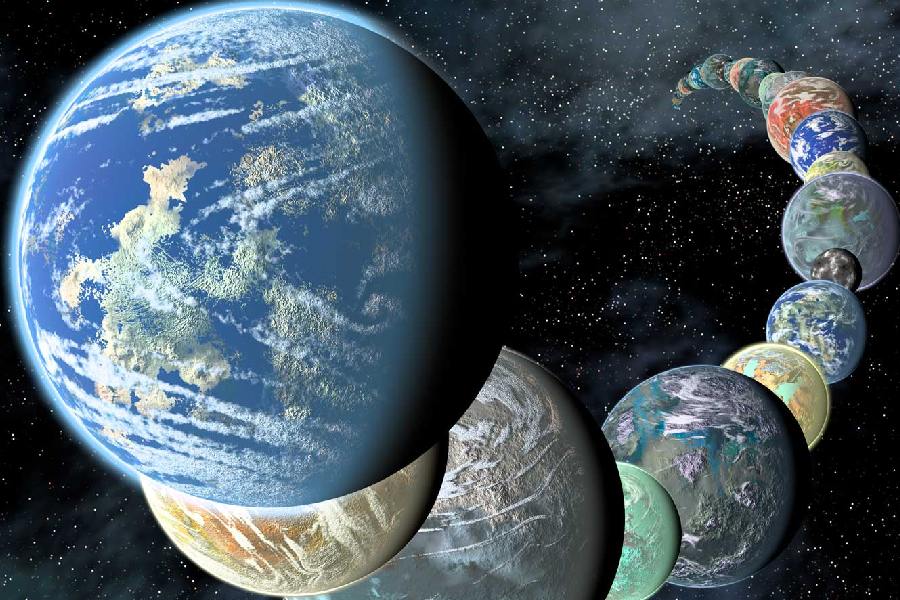Our Solar System contains four inner planets known as the terrestrial planets. These intriguing worlds have much to reveal about planet formation and whether life can exist elsewhere in the universe. So, what are some of the most fascinating terrestrial planets facts?
In this article, we will uncover interesting facts about terrestrial planets, including their location, size, structure, surface features, atmospheres, etc. Learn what sets these densely packed inner worlds apart from the gas and ice giants of the outer Solar System.
Let’s begin!

Fascinating Terrestrial Planets Facts
The terrestrial planets, including Mercury, Venus, Earth, and Mars, exhibit fascinating characteristics within our Solar System. Mercury, the closest planet to the Sun, experiences extreme temperature variations, swinging from scorching heat to frigid cold due to its thin atmosphere.
Venus, often called Earth’s “sister planet”, has a thick, toxic atmosphere primarily composed of carbon dioxide and sulfuric acid clouds. Earth, our home, is distinguished by its ability to support a wide array of life, featuring diverse ecosystems, climates, and geological formations.
Moreover, Mars, known as the “Red Planet”, showcases a rusty surface due to iron oxide and harbors the towering Olympus Mons, the largest volcano in our Solar System.
Characteristics of Terrestrial Planets
Terrestrial planets, characterized by solid surfaces and atmospheres, starkly contrast to gas giants. These inner planets boast high density and exhibit considerable geological activity, setting them apart from their gaseous counterparts.
Retaining atmospheres
The terrestrial planets each have their atmosphere. Venus has a thick, hot carbon dioxide atmosphere. Earth’s atmosphere is a mix of nitrogen and oxygen that we can breathe.
Mars has a thin atmosphere mostly made of carbon dioxide. Mercury hardly has an atmosphere at all.
Potential for life
Some planets, like Earth, can support life, while others show signs they might have had habitable conditions. Mars, for example, might have had life-friendly environments before losing its atmosphere and water. Scientists are hopeful about finding basic signs of life on Mars.
Solid surfaces
Terrestrial planets have solid surfaces made of rock, allowing for geology. The inner planets cooled enough for heavier metals and minerals to solidify, forming solid surfaces. These surfaces provide foundations for varied terrain across the terrestrial worlds.
Solid land also interacts with atmospheres and water. This geological activity drives planetary diversity through features like mountains, volcanoes and canyons.
Earth
Earth has an incredibly diverse solid surface. It is composed of tectonic plates that have shifted land masses over eons. Continents and oceans are continuously changing shape.
Earth also has active volcanoes due to internal heating and plate movement processes. The geology has allowed complex lifeforms to emerge.
Mars
Mars used to have volcanoes on its surface, and there is proof. Olympus Mons is the Solar System’s biggest volcano. But now, Mars doesn’t have any active volcanoes.
The cold and empty landscape suggests that warm temperatures and water vanished long ago. Still, the past possibility of life makes us hopeful for missions to detect basic life forms.
Closest Planets to Earth
Innermost planet: Mercury
Mercury is the smallest and innermost planet. Understanding this extreme world has value. This rocky and cratered planet circles the Sun in just 88 Earth days. It has experienced the most radical day-night temperature variations of any planet.
The temperature swings from 800 °F on its day to -290 °F on its night side. Studying sun-scorched Mercury’s formation and odd orbit aids in modeling planetary system evolution.
Extreme rotation
Mercury has a very slow rotation period. Mercury rotates three times for every two orbits around the Sun. This resonance between rotation and revolution is responsible for unusual day lengths.
These day lengths are equivalent to 176 Earth days. This contributes to extreme hot and cold cycles on Mercury’s airless surface.
Shrinking planet
Mercury is the smallest planet for a reason. Mercury likely had a larger silicate mantle stripped away in collisions during formation.
This left an abnormally large iron-nickel core relative to the planet’s surface area. The dense core causes Mercury to have the highest density in the Solar System after Earth.

Closest rocky planet: Venus
Venus is Earth’s closest neighbor in size and orbit. But under its clouds lies a scorched landscape. Similar in structure yet radically different in surface conditions from Earth, studying Venus helps us understand terrestrial planet evolution.
Venus provides a greenhouse warning sign under its mystery, shrouding sulfuric acid clouds. Brief Soviet Venera missions to the surface revealed a barren, cratered rock-scape hot enough to melt lead.
Hellish atmosphere
Venus has a dense carbon dioxide atmosphere. Surface pressures on Venus are over 90 times that on Earth, thanks to its predominantly CO2 atmosphere. This creates a runaway greenhouse effect.
This effect pushes surface temperatures over 860 °F. It is hot enough to melt lead. Lightning storms crackle through thick cloud layers of sulfuric acid that completely enshroud the planet.
Warped surface
The Venusian surface has unusual continent-like formations. Radar mapping has revealed huge land masses forming circular shapes called coronae.
Venus also has volcanic surface features. These include pancake dome volcanoes and giant shield volcanoes. But the harsh environment means no liquid water can exist to create erosion patterns seen on Earth.
Water Content on Terrestrial Planets
The presence of liquid water in oceans, seas, and lakes characterizes terrestrial planets like Earth. In colder regions and on celestial bodies like Mars, water takes the form of ice, showcasing a diverse range of water states across the Solar System.
Implications for planetary habitability
Liquid water is a fundamental element for supporting life, acting as a vital ingredient for habitability on terrestrial planets. The presence of water plays a pivotal role in determining a planet’s suitability for sustaining various life forms.
Water’s role in planetary processes
Beyond its role in supporting life, water actively shapes planetary surfaces through geological processes such as erosion and deposition. Additionally, the water cycle, a dynamic system, contributes significantly to climate regulation on Earth, showcasing the multifaceted influence of water in planetary dynamics.
Water’s influence on atmospheric conditions
Water extends its influence beyond the surface, impacting atmospheric conditions. The presence of water vapor contributes to atmospheric dynamics. It influences weather patterns and adds another layer to the intricate interplay of cosmic forces within our Solar System.
Liquid Water, Water Ice, and Water Vapor
Liquid water is a hallmark of habitability on Earth, with vast bodies supporting various life forms. Its dynamic nature contributes to the planet’s ability to sustain diverse ecosystems.
Water ice in colder regions
Beyond liquid water, colder realms and planets exhibit the frozen state of water. This sculpts icy landscapes and contributes to distinctive features like Mars’ polar ice caps. These frozen reservoirs play a significant role in shaping the planet’s appearance and influencing climate dynamics.
Water vapor and atmospheric influence
Water vapor, a key atmosphere component, is crucial in maintaining a stable climate on terrestrial planets. Its dynamic presence contributes to the intricate dance of weather patterns, impacting temperature, precipitation, and overall atmospheric conditions.
The interplay between water states
The coexistence of these water states results in dynamic interactions. These dynamic interactions contribute to planetary processes like climate regulation and surface transformations through evaporation, condensation, and precipitation cycles.
Carbon Dioxide Levels on Earth-Like Worlds
The significance of carbon dioxide levels on Earth-like worlds lies in their crucial role in shaping the climate and habitability of these planets. Carbon dioxide is a greenhouse gas that influences temperature regulation by trapping atmospheric heat. Adequate but not excessive levels are vital for maintaining a stable climate conducive to life as we know it.
Too much carbon dioxide can lead to a runaway greenhouse effect, causing extreme warming, while too little can result in a frigid environment. Striking the right balance of carbon dioxide levels is pivotal for sustaining Earth-like conditions and the potential for life to thrive on such worlds.
Conclusion
In unraveling the diverse fabric of terrestrial planets, we delved into the dynamic interplay of liquid water, water ice, and water vapor across these rocky worlds.
From the vital role of liquid water in fostering diverse ecosystems—each state contributes uniquely to planetary dynamics. The sculpting influence of water ice in colder realms is significant in shaping planetary features and landscapes.
The atmospheric dance of water vapor further shapes climate dynamics and weather patterns. As we conclude this cosmic journey illuminating terrestrial planets facts, we hope you have gained insights into the multifaceted role of water on terrestrial planets.
